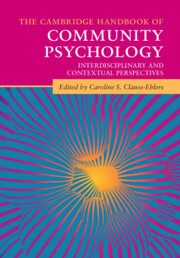Book contents
- The Cambridge Handbook of Community Psychology
- The Cambridge Handbook of Community Psychology
- Copyright page
- Dedication
- Contents
- Figures
- Tables
- Contributors
- Foreword
- Part I Foundational Concepts
- Part II Research, Assessment, and Program Evaluation
- Part III Community Psychology in Action
- 10 Women and Leadership
- 11 Community Resilience
- 12 Building Community Resilience and Supporting Disaster Risk Reduction through Social Action Efforts
- 13 The Consumer Recovery Movement in the United States
- 14 Taking Back the Streets
- 15 Promoting Adolescent Mental Health
- 16 Gowanus Canal and Public Policy
- 17 Family Support Services at Ronald McDonald House Promotes Healing of Seriously Ill Children
- 18 Community Psychology and a Fresh Look at Faith Healing Camps
- 19 Community Impact of Social Media
- 20 Supporting Communities through Educational Access
- 21 Psychological Impact of Climate Change on Communities
- 22 Optimal Local Government and Public Service Provision
- 23 A Public Health Approach to Delinquency and Incarceration
- 24 Public Service Organizations and Community Empowerment
- 25 Women and Immigration
- 26 Community-Based Transition Interventions for Adolescents and Young Adults with Neurodevelopmental Disabilities
- 27 Mental Health on College Campuses
- 28 LGBTQ+ Communities
- Part IV Where Do We Go from Here?
- Index
- References
25 - Women and Immigration
from Part III - Community Psychology in Action
Published online by Cambridge University Press: 16 December 2021
- The Cambridge Handbook of Community Psychology
- The Cambridge Handbook of Community Psychology
- Copyright page
- Dedication
- Contents
- Figures
- Tables
- Contributors
- Foreword
- Part I Foundational Concepts
- Part II Research, Assessment, and Program Evaluation
- Part III Community Psychology in Action
- 10 Women and Leadership
- 11 Community Resilience
- 12 Building Community Resilience and Supporting Disaster Risk Reduction through Social Action Efforts
- 13 The Consumer Recovery Movement in the United States
- 14 Taking Back the Streets
- 15 Promoting Adolescent Mental Health
- 16 Gowanus Canal and Public Policy
- 17 Family Support Services at Ronald McDonald House Promotes Healing of Seriously Ill Children
- 18 Community Psychology and a Fresh Look at Faith Healing Camps
- 19 Community Impact of Social Media
- 20 Supporting Communities through Educational Access
- 21 Psychological Impact of Climate Change on Communities
- 22 Optimal Local Government and Public Service Provision
- 23 A Public Health Approach to Delinquency and Incarceration
- 24 Public Service Organizations and Community Empowerment
- 25 Women and Immigration
- 26 Community-Based Transition Interventions for Adolescents and Young Adults with Neurodevelopmental Disabilities
- 27 Mental Health on College Campuses
- 28 LGBTQ+ Communities
- Part IV Where Do We Go from Here?
- Index
- References
Summary
Approximately half of migrants worldwide are women and girls. Women’s experiences of migration are shaped by contextual factors, such as employment, financial resources, family structure and dynamics, sociopolitical climate, abuse and violence, and documentation status. Further, women’s responses to adapting to a new sociocultural environment often necessitates shifts in roles and positions within family and broader society. Guided by an ecological framework, this chapter provides an overview of salient factors that impact migrant women’s experiences of stress and resilience. We emphasize the dynamic interaction of multiple layers of context and development, including the influence of sociopolitical climate on mental health and access to resources (APA, 2012; Clauss-Ehlers et al., 2019). While recognizing that women have unique experiences of migration across different regions of the world, in this chapter we focus specifically on experiences of immigrant women in the USA, and provide a case illustration of how immigrant women may experience risk and protective factors.
- Type
- Chapter
- Information
- The Cambridge Handbook of Community PsychologyInterdisciplinary and Contextual Perspectives, pp. 511 - 538Publisher: Cambridge University PressPrint publication year: 2021



